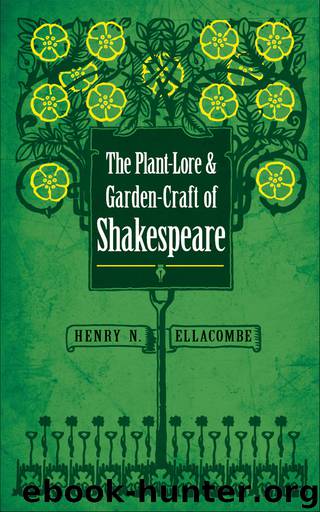The Plant-Lore and Garden-Craft of Shakespeare by Ellacombe Henry N.;

Author:Ellacombe, Henry N.;
Language: eng
Format: epub
Publisher: Dover Publications
Published: 2017-04-12T04:00:00+00:00
Pear.
(1)I warrant they would whip me with their fine wits till I were as crest-fallen as a dried Pear.—Merry Wives of Windsor, iv. 5, 101.
(2)Your virginity, your old virginity, is like one of our French withered Pears, it looks ill, it eats drily; marry, ’tis a withered Pear; it was formerly better; marry, yet ’tis a withered Pear.
All’s Well that Ends Well, i. 1, 174.
(3)I must have Saffron to colour the Warden pies.
Winter’s Tale, iv. 3, 48.
(4)O, Romeo . . . thou a Poperin Pear.
Romeo and Juliet, ii. 1, 37.
If we may judge by these few notices, Shakespeare does not seem to have had much respect for the Pear, all the references to the fruit being more or less absurd or unpleasant. Yet there were good Pears in his day, and so many different kinds that Gerard declined to tell them at length, for “ the stocke or kindred of Pears are not to be numbered; every country hath his peculiar fruit, so that to describe them apart were to send an owle to Athens, or to number those things that are without number.”
Of these many sorts Shakespeare mentions by name but two, the Warden and the Poperin, and it is not possible to identify these with modern varieties with any certainty. The Warden was probably a general name for large keeping and stewing Pears, and the name was said to come from the Anglo-Saxon wearden, to keep or preserve, in allusion to its lasting qualities. But this is certainly a mistake. In an interesting paper by Mr. Hudson Turner, “ On the State of Horticulture in England in early Times, chiefly previous to the fifteenth century,” printed in the “ Archæological Journal,” vol. v. p. 301, it is stated that “ the Warden Pear had its origin and its name from the horticultural skill of the Cistercian Monks of Wardon Abbey in Bedfordshire, founded in the twelfth century. Three Warden Pears appeared in the armorial bearings of the Abbey.”
It was certainly an early name. In the “ Catholicon Anglicum” we find: “ A Parmayn, volemum, Anglice, a Warden;” and in Parkinson’s time the name was still in use, and he mentions two varieties, “The Warden or Lukewards Pear are of two sorts, both white and read, both great and small.” (The name of Lukewards seems to point to St. Luke’s Day, October 18, as perhaps the time either for picking the fruit or for its ripening.) “ The Spanish Warden is greater than either of both the former, and better also.” And he further says : “ The Red Warden and the Spanish Warden are reckoned amongst the most excellent of Pears, either to bake or to roast, for the sick or for the sound—and indeed the Quince and the Warden are the only two fruits that are permitted to the sick to eat at any time.” The Warden pies of Shakespeare’s day, coloured with Saffron, have in our day been replaced by stewed Pears coloured with Cochineal.163
I can
Download
This site does not store any files on its server. We only index and link to content provided by other sites. Please contact the content providers to delete copyright contents if any and email us, we'll remove relevant links or contents immediately.
Turbulence by E. J. Noyes(7720)
The Thirst by Nesbo Jo(6457)
Gerald's Game by Stephen King(4386)
Be in a Treehouse by Pete Nelson(3654)
Marijuana Grower's Handbook by Ed Rosenthal(3520)
The Sprouting Book by Ann Wigmore(3423)
The Red Files by Lee Winter(3286)
The Remains of the Day by Kazuo Ishiguro(3148)
Sharp Objects: A Novel by Gillian Flynn(2852)
Christian (The Protectors Book 1) by L. Ann Marie(2607)
Organic Mushroom Farming and Mycoremediation by Tradd Cotter(2573)
The Culinary Herbal by Susan Belsinger(2342)
Stone Building by Kevin Gardner(2297)
Lilac Girls by Martha Hall Kelly(2205)
The Starter Garden Handbook by Alice Mary Alvrez(2203)
The Unlikely Pilgrimage of Harold Fry by Rachel Joyce(2140)
The Lean Farm Guide to Growing Vegetables: More In-Depth Lean Techniques for Efficient Organic Production by Ben Hartman(2014)
Urban Farming by Thomas Fox(1987)
Backyard Woodland by Josh VanBrakle(1837)
